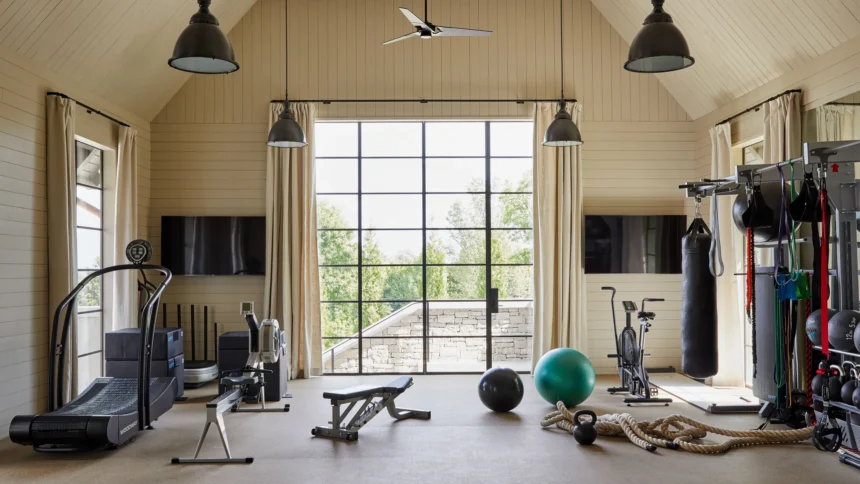Imagine stepping into your very own sanctuary of fitness, where every corner is designed to motivate you and help you reach your goals. A home gym provides not just convenience, but the freedom to work out on your schedule. No more crowded spaces or waiting for equipment; everything you need is right at hand.
But how do you create an effective workout haven in a compact area? Whether you’re working with a spare bedroom, a tiny garage, or even just a corner of your living room, transforming that space into an inviting gym is entirely possible. With some thoughtful planning and creativity, you’ll discover how easy it can be to maximize space while creating an environment that inspires movement and progress. Let’s dive into the essentials of designing a compact yet powerful home gym!
The Benefits of Having a home gym
Having a home gym opens up a world of convenience. You can work out whenever it suits you, without worrying about gym hours or travel time. This flexibility makes it easier to stick to a routine.
Cost savings are another major advantage. While the initial investment in equipment may seem steep, think about all the monthly fees you’ll avoid over time. No more expensive memberships or hidden costs.
Privacy also plays a significant role. Many people feel self-conscious at public gyms; having your own space allows for freedom and comfort while exercising.
Furthermore, you can tailor your workouts specifically to your preferences and goals. Choose the exercises that resonate with you and ditch those that don’t spark joy.
Creating an inspiring environment boosts motivation. Design it just how you like — from color schemes to decor — making every workout something to look forward to!
Assessing Your Space and Budget
Before diving into your home gym project, take a close look at the space you have available. Whether it’s a corner of your living room, a spare bedroom, or even your garage, every square foot counts. Measure the area to determine how much room you can dedicate to workouts.
Next, consider your budget. Home gyms come in various price ranges. Decide how much you’re willing to invest upfront and remember that quality often trumps quantity.
Prioritize essential equipment based on your fitness goals and the activities you enjoy most. This way, you’ll avoid overspending on items that may collect dust rather than enhance your workout routine.
Think about potential renovations or adjustments needed for optimal use of space. A little creativity can turn an ordinary area into a motivating exercise haven without breaking the bank.
Choosing the Right Equipment
Selecting the right equipment for your home gym is crucial. Think about your fitness goals first. Are you aiming to build strength, improve cardio, or enhance flexibility? Each goal requires different tools.
If space is limited, consider multi-functional equipment. Items like adjustable dumbbells and resistance bands can provide a full-body workout without taking up much room.
Don’t overlook bodyweight exercises either. A sturdy yoga mat and perhaps a pull-up bar are great additions that require minimal storage.
Budget plays a role too. Prioritize quality over quantity; investing in fewer high-quality pieces often yields better results than filling your space with cheaper options that might not last.
Try before you buy when possible. Testing equipment ensures it feels comfortable and suits your style of training perfectly. The right gear makes all the difference in maintaining motivation and consistency on your fitness journey.
Creative Storage Solutions for Small Spaces
Maximizing space in a compact home gym requires some creative thinking. Wall-mounted shelves are great for storing weights or yoga mats, keeping the floor clear and organized.
Consider using multi-functional furniture. An ottoman with storage inside can double as a seat and hide away resistance bands or small equipment.
Pegboards offer versatility. Hang your jump ropes, towels, and even dumbbells on hooks to keep them easily accessible yet off the ground.
Don’t forget about underutilized areas like under beds or benches. These spots are perfect for stashing smaller items out of sight but within easy reach.
Collapsible gear is a must-have! Look for foldable exercise bikes or stackable kettlebells that can be tucked away when not in use. This way, you’ll maintain an open space without sacrificing functionality.
Design Tips for an Efficient and Motivating Home Gym
Creating an efficient and motivating home gym starts with selecting the right location. Choose a space that is well-lit and has good airflow. Natural light can uplift your mood.
Next, consider color schemes. Bright colors like yellow or orange can energize you, while calming shades of blue promote focus. Paint the walls in tones that inspire movement and positivity.
Organization plays a crucial role too. Keep everything within reach but neatly stored away to avoid clutter. Use wall-mounted shelves for smaller equipment, allowing more floor space for workouts.
Incorporate mirrors to visually expand your area and help with form checks during exercises. Adding personal touches such as motivational quotes or photos can enhance your environment, making it feel uniquely yours.
Keep technology handy—set up speakers for music or install a TV to follow workout videos easily. This variety keeps things fresh and engaging!
Incorporating Technology for Variety and Progress Tracking
Embracing technology in your home gym can elevate your workout experience. Apps and wearables make it easy to track progress and stay motivated.
Consider fitness trackers that monitor heart rate, calories burned, and activity levels. They provide insights into your performance over time. This data helps you adjust your routines effectively.
Streaming services offer a wide range of classes right from the comfort of your space. From yoga to high-intensity interval training, there’s something for everyone. You can even join live sessions with friends or trainers for added motivation.
Smart mirrors are another innovative option, providing real-time feedback on form and technique during workouts. Plus, they save valuable floor space while doubling as a stylish decor element.
Integrating these technological advancements ensures variety in workouts while keeping you accountable on your fitness journey.
Conclusion
Designing a compact and effective home gym is an exciting venture that can transform how you approach fitness. With the right planning, you can create a space tailored to your needs while maximizing every inch of available room.
Consider all the benefits—convenience, cost savings, and flexibility in your workout schedule. By assessing your space and budget carefully, you’re setting the stage for success. Choosing versatile equipment ensures you get the most out of what little space you have. Creative storage solutions will keep things organized and clutter-free.
Adding personal touches through design not only enhances functionality but also makes exercising feel more inviting. Incorporating technology helps maintain variety in workouts and allows for tracking progress over time.
Creating a home gym isn’t just about working out; it’s about building a lifestyle that prioritizes health within the confines of your own sanctuary. Embrace this journey to fitness at home with confidence!





